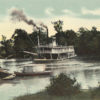calsfoundation@cals.org
Skirmish at L'Anguille Ferry
| Location: | St. Francis County |
| Campaign: | LaGrange’s Expedition in to Arkansas |
| Date: | August 3, 1862 |
| Principal Commanders: | Major Henry S. Eggleston (US); Colonel William Henry Parsons (CS) |
| Forces Engaged: | First Wisconsin Cavalry; Commander Oscar LaGrange (US); Twelfth Texas Cavalry; General Thomas Hindman’s Command (CS) |
| Estimated Casualties: | 17 killed, 40 wounded (US); 2 killed, 9 wounded (CS) |
| Results: | Confederate victory |
On August 3, 1862, a skirmish took place at L’Anguille Ferry, just north of Marianna (Lee County). The skirmish was in direct response to a Union victory at the Action at Hill’s Plantation, which took place July 7. The Confederate victory at L’Anguille Ferry resulted in Union troops in eastern Arkansas remaining near the Mississippi River until the following year.
One of the regiments so affected by the Action at Hill’s Plantation in Woodruff County was that of Colonel William H. Parsons of Texas. He planned to avenge his loss to the Union at Hill’s Plantation. With the blessing of General Thomas C. Hindman, he went searching for a target. The First Wisconsin Cavalry, under the command of Colonel Edward Daniels, was the closest. Daniels and his army were on Crowley’s Ridge just south of Wittsburg (Cross County) traveling south to Helena (Phillips County) to help in the defense of the Mississippi River and Helena’s port. The Federals had the numbers and equipment to push the Confederates out of the way on their journey south; the Confederates were only effective using hit and run tactics.
The lead group, with Commander Oscar LaGrange in charge, reached Marianna on July 29. The rear command, the Second Battalion of the First Wisconsin Cavalry, was under newly promoted Major Henry S. Eggleston. It was loaded down by a train of baggage wagons and liberated slaves from the Delta. Eggleston issued an order to admit no more contraband under age fifteen to the camp, for they could handle no more liberated slaves.
The Second Battalion left Wittsburg the morning of July 29 and arrived at the L’Anguille Ferry on August 2. The troops made camp and waited for orders to cross the river. Eggleston reported that he had twenty-seven wagons, 130 men (sick and well), and about 100 contraband horses and mules. The camp was half a mile from the crossing. He placed twenty-four pickets and camp guards besides the horse guard.
Colonel Parsons’s plan was to divide the Twelfth Texas Cavalry into five squadrons. Parsons and Major Lochlin J. Farrar would lead four squads, while Lieutenant Colonel Bell Burleson and a fifth squadron would circle from the southwest to position themselves north of the Federal soldiers. This was to cut off any retreat northward up the Military Road. Lieutenant Woinder N. Kenner led the advance that morning. The Texans got so close to the pickets that the Federals thought they were more Union soldiers coming into the camp. Most of the guards, who had been on duty all night, were tired, with some of them sleeping. One of the pickets awoke, was surprised to see the Confederates, and fired his weapon. This resulted in the order from Parsons to charge. Parsons, with more than 600 Texas Cavalry, attacked from all directions. After severe fighting for half an hour, the Federals started to yield. The Wisconsin men thought they were being attacked by Missourians, the only troops they knew to be in the area, though soon the Confederates got close enough that the Union troops could see the Texan dress and brass insignia upon their enemies. The Federals soon fled to the woods and streams for cover. The Confederates captured seven wagons, all the horses and mules, and burned or destroyed everything of value not taken.
Union losses totaled seventeen killed, forty wounded, twenty-five captured, and eight missing. Parsons reported that he had lost two killed and ten wounded. The Reverend George W. Densmore, the chaplain for the First Wisconsin, was mortally wounded as he exited his tent.
LaGrange sent a report to General Samuel R. Curtis that an African American brought news of the attack at L’Anguille Ferry at 9:40 a.m. on August 3. LaGrange and Major William H. Torrey, with 200 men, marched as fast as they could to a point eight miles north of the ferry, hoping to surprise the Texans. LaGrange reported to General Samuel Curtis that they came upon the site of the skirmish and found that the enemy was gone and that all that was left was burning wagons. He also said a considerable amount of stock was taken, and the regimental desk and many papers were lost to the enemy.
The Federals had their hands full taking care of their wounded. They loaded them on the steamboat Hamilton Belle for the journey to Helena and buried many comrades at the battle site.
The Confederate victory at L’Anguille Ferry resulted in Union troops staying close to Helena and defending the port so the Mississippi River would be in Federal control—at least to that point. It would be another year before Vicksburg, Mississippi, would fall and the Union would have control of the entire Mississippi River.
For additional information:
Bailey, Anne J. Between the Enemy and Texas: Parsons’s Texas Cavalry in the Civil War. Fort Worth: Texas Christian University Press, 1989.
The War of the Rebellion: A Compilation of the Official Records of the Union and Confederate Armies. Vol. 25. Washington DC: Government Printing Office, 1890-1901, p. 202–205.
W. Danny Honnoll
Jonesboro, Arkansas
 Civil War Timeline
Civil War Timeline L'Anguille River
L'Anguille River Military
Military




Comments
No comments on this entry yet.